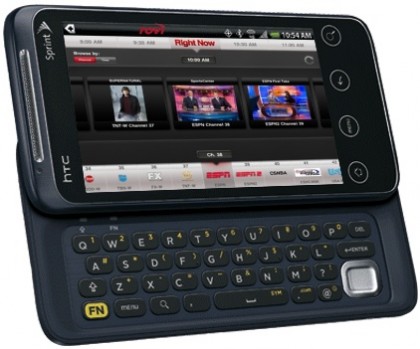
Word surfaced earlier this week that Rovi has a new Connected Platform coming to Android. And while we assumed the underlying software stack had to be based on DLNA, a quick note to our Rovi sources has confirmed it. Rovi now joins Skifta in enabling media streaming from an Android mobile device to any DLNA-compliant hardware.
I was enthused, but a bit skeptical when I first wrote about Skifta in December. However, since then I’ve started to warm to the idea of streaming content from a mobile device. Even if you assume that most TVs will soon be able to access content from the cloud without requiring any device-to-device connection, there is still an opportunity in the mobile app space. If people use their mobile devices increasingly to capture or acquire media, these new DLNA-based platforms provide an easy way to port the experience to a larger screen. Standard photos and movies are one thing, but think about the possibilities too with interactive apps. Let’s say you used your smartphone to take pictures of the family and create an Elf Yourself card. You could then, in theory, play back your video creation instantly on the living-room flat screen with a platform like the Rovi or Skifta offering.
Rovi, meanwhile, is an interesting brand to enter into this space. Known for its electronic program guides, the company is an established player in the pay-TV world. And from the wording in its press release, it sounds like Rovi is specifically courting hardware players – like TV and set-top manufacturers – that want to expand their mobile services. Many of those CE players are probably testing out their own DLNA stacks, but if Rovi can get a foothold in the market and convince hardware providers that they don’t want to manage the extra work, it has a chance to expand the Rovi footprint beyond its traditional EPG territory. In fact, given that Rovi announced at CES that Samsung is using its entertainment data and advertising on Samsung Smart TVs, I have to wonder if Rovi might also be involved in Samsung’s One-Foot Connection technology.
This will catch on when it’s baked into the Android OS, when DLNA becomes standard on internet connected TVs, and when they both become more user friendly. For now your average consumer can barely figure out AirPlay, if they even know what it is.
What is more interesting? – The other direction. I’ve been using PlayOn on Android and it works reasonably well.
Most of the phone manufacturers such as HTC or Samsung provides their own DLNA applications inside their Android phones. On my side, I use the Android AwoX mediaCTRL application and it does a great job at pushing quickly my apps to my Samsung TV.